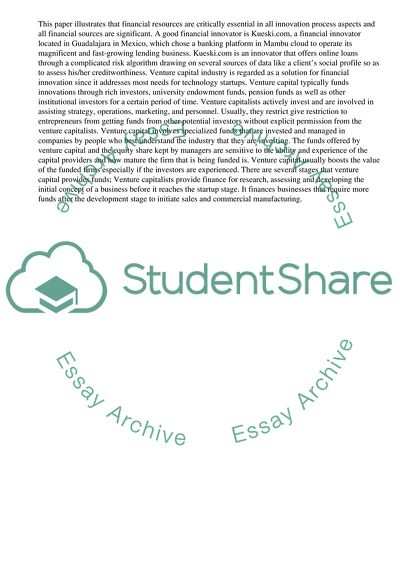Cite this document
(“Finance for Innovation Essay Example | Topics and Well Written Essays - 2500 words”, n.d.)
Finance for Innovation Essay Example | Topics and Well Written Essays - 2500 words. Retrieved from https://studentshare.org/management/1632781-discuss-different-sources-of-finance-for-innovation-in-your-essay-make-reference-to-a-specific-innovator-discuss-the-impact-if-any-of-the-recent-global-financial-crisis-on-the-availability-of-funding-for-innovation
Finance for Innovation Essay Example | Topics and Well Written Essays - 2500 words. Retrieved from https://studentshare.org/management/1632781-discuss-different-sources-of-finance-for-innovation-in-your-essay-make-reference-to-a-specific-innovator-discuss-the-impact-if-any-of-the-recent-global-financial-crisis-on-the-availability-of-funding-for-innovation
(Finance for Innovation Essay Example | Topics and Well Written Essays - 2500 Words)
Finance for Innovation Essay Example | Topics and Well Written Essays - 2500 Words. https://studentshare.org/management/1632781-discuss-different-sources-of-finance-for-innovation-in-your-essay-make-reference-to-a-specific-innovator-discuss-the-impact-if-any-of-the-recent-global-financial-crisis-on-the-availability-of-funding-for-innovation.
Finance for Innovation Essay Example | Topics and Well Written Essays - 2500 Words. https://studentshare.org/management/1632781-discuss-different-sources-of-finance-for-innovation-in-your-essay-make-reference-to-a-specific-innovator-discuss-the-impact-if-any-of-the-recent-global-financial-crisis-on-the-availability-of-funding-for-innovation.
“Finance for Innovation Essay Example | Topics and Well Written Essays - 2500 Words”, n.d. https://studentshare.org/management/1632781-discuss-different-sources-of-finance-for-innovation-in-your-essay-make-reference-to-a-specific-innovator-discuss-the-impact-if-any-of-the-recent-global-financial-crisis-on-the-availability-of-funding-for-innovation.


